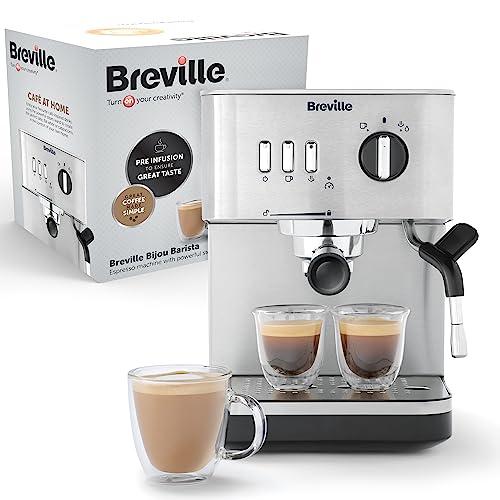best home espresso machine and Espresso Machines
Espresso machines make use of pressure to push water into finely roasted and tamped beans. They produce a rich, delicious cup.
Experts at the Good Housekeeping Institute recommend models that brew at a minimum pressure of 9 bars in order to get the best extraction. Beware of brands that claim to use more pressure than is needed.
Types
The espresso maker (also called a coffee maker and Espresso maker) creates coffee that is more concentrated, of higher quality, and is more expensive than your usual coffee drinks at the cafe. It works with an average of nine bars of pressure. The machines come with a variety of options, such as temperature control and brew-strength control, programmable brewing and various drink sizes. They may also come with steam wands that are either automatic or manual to create texturized milk for latte art. They can be found in three major types of espresso machines, including semi-automatic, automated, and super-automatic models. Each model has its own degree of supervision and automation.
The most well-known espresso machine model for specialty coffee shops is semi-automatic models. This allows baristas to have complete control over the brewing process but it is not as user-friendly as a fully automated machine. To get the most perfect espresso shot, you must grind the beans, fill the portafilter with water, press it down, and alter the extraction time.
Automated machines have a built-in grinder and measure and tamp the grounds for you. They automatically disperse enough water to extract espresso, and typically have an adjustable beverage size. Our lab tests revealed that they were the most favored type of espresso machine. They provide a great combination of consistency and manual control.
Functions
No matter if you opt for a pump-driven machine or a steam-driven one, you'll have an accumulator that holds the water needed to make your coffee. You'll also have an element of heating that heats the cold water to produce the high pressure needed to extract coffee from ground.

When the brew lever is lifted, it triggers the water inlet cam that seals the pre-infusion valve so only hot water that has been pressurized to the maximum pressure flows through the portafilter to ground coffee. The water takes approximately 25 seconds before it turns into espresso.
The hot-water tubing, also referred to as the insulated tube, extends from the reservoir to the spout at top of your machine. The resistance heating element warms the water as water passes through the aluminum tube and metal warming plate.
Once the spout is switched on, you'll need to place your cup in the spout to catch the espresso as it flows through the portafilter into your cup. The coffee maker also come with a steam wand which you can use to heat and froth milk for drinks made with espresso, like cappuccino or the latte.
Automatic machines eliminate the guesswork from making a cup of coffee. They operate with a single button that can be programmed to grind and measure beans for you and grind them down. In our Lab tests, they generally perform best due to their being user-friendly and don't require an extensive amount of user expertise.
Materials
Inside an espresso machine, you'll find a plethora of copper tubes and stainless steel boilers. There's also an intelligent software. It may appear to be complicated but at the core they perform one thing: push hot water through coffee that has been finely ground.
When you are buying an espresso machine, you should consider the dimensions and space requirements, as in addition to drink options, energy-saving options, and brewing precision. Also, look for a steam knob which will activate the steam wand that can be used to froth milk and making Latte art. A gauge of pressure on front of the machine lets you know the boiler's and pump's operational pressure. Find a coffee maker with two needles, so that you can observe both the maximum and minimum pressure.
If you're looking to do more than espresso, you should choose a machine that offers different sizes of brews, including the ristretto. There are also models with an hopper that can be removed for free, effortless frothing, and the ability to easily change between different types of milk. If you're suffering from hard water, you should choose the model that has an integrated softener for your water to avoid mineral build-up and keep your espresso tasting fresh.
Some manufacturers use a thermostat that is digital integral and proportional to keep a certain temperature range when brewing espresso. This feature helps ensure a consistent, high-quality cup of espresso every time. It also saves on cost of energy, as the machine only operates when it's needed.
Maintenance
The care and maintenance of espresso and coffee machines is becoming more important as they become available for home use. Having the best equipment can make a world of difference in your cup of coffee, but that's only true if your machine is working properly.
Regular maintenance and cleaning must consist of everything from cleaning the group head, steam wand and water filter to descaling and changing the water filters regularly. If you make between two and five cups of coffee each day, it is recommended that you clean the main parts of the machine once a week. However, some parts of the machine, like the water tank and the grinder, will need to be cleaned every two or three weeks.
In addition, you must backflush your system on a weekly basis. This involves placing the portafilter in its place and running the brew cycles multiple times. This can help to eliminate any stray coffee grounds or oils left behind. You can also clean the portafilter by using a brush and cleaner designed specifically for espresso machines.
Maintaining your espresso and coffee machine properly can ensure that it lasts longer. It is important to take care of the expensive espresso machine.
